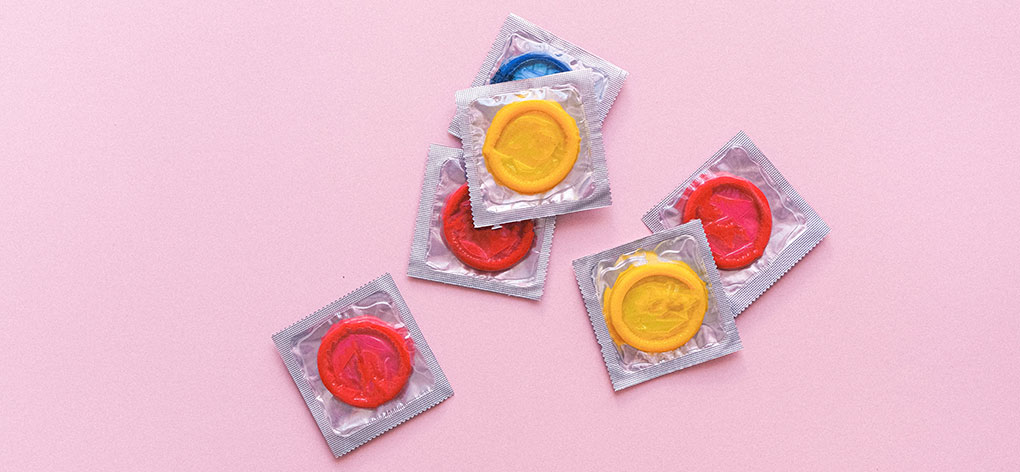In use for over 4,000 years, condoms were once made of animal intestines, protecting ancient Egyptians, Babylonians and Romans against… evil spirits? Casanova, the famous lover, made condoms popular in the eighteenth century, as he chronicled his exploits in a series of twelve books. Condoms took on the nickname “rubbers” in the 1840s, after Charles Goodyear patented the vulcanization of rubber, which allowed condoms to be inexpensively mass-produced.
Up to the early 1960s, condoms were used, but never discussed. During the sexual revolution of the 1960s, condom use dropped off as more people engaged in free love without thought of repercussions. After the onset of the HIV epidemic in the 1980s, condoms became a necessary component to intercourse, prompting Planned Parenthood to recommend distributing them freely to everyone, including teenagers. Today, most people would never consider having non-monogamous intercourse without a condom.
Anatomy of a Condom
Condoms have three main parts: On one end is a rubbery ring that helps keep the condom on your penis during intercourse. On the other end, most condoms have a reservoir tip, which catches ejaculate after you have an orgasm. In between is a sheath, which protects your penis from infection.
Contraception
Condoms are one of the most effective forms of birth control available, preventing pregnancy 98% of the time when used correctly. Classified as a “barrier method“, condoms act as a shield between you and your partner, preventing sperm from getting out and infection from getting in.
Safer Sex
When used correctly, condoms are effective 99% of the time at preventing the transmission of most infections, including vaginitis, trichomoniasis, pelvic inflammatory disease (PID), gonorrhea, chlamydia, syphilis, chancroid and HIV. Condoms offer some protection against the human papilloma virus (HPV), which can cause genital warts, the herpes simplex virus, which causes genital herpes, and the hepatitis-B virus. Condoms don’t do a lot against critters, such as scabies or pubic lice, which hop from body to body with ease.
Materials
Most condoms are made from latex, an inexpensive material that is strong, stretchy and thin. Latex allows a great deal of sensation during intercourse and provides the best protection against STDs. Some people are allergic to latex, developing a persistent itch or rash when they use it. If you experience such symptoms, first try using condoms without spermicide – many people who think they are allergic to latex are actually allergic to nonoxynol-9 – and then switch to a plastic or skin condom only if the allergic reaction persists.
Plastic or polyurethane condoms are a non-latex, hypoallergenic alternative for those with a latex allergy. Because they are plastic, you can use oil-based or water-based lube with them. They are stronger and thinner than latex condoms, as well as nonporous and non-permeable to all STDs including HIV. So, they are just as effective as latex condoms.
Natural membrane – or “skin” – condoms are usually made from lambskin, which does not irritate the skin. Because skin condoms are thinner than latex condoms, many people say they experience more sensation during intercourse. However, skin condoms are slightly less effective at preventing pregnancy and more expensive than latex condoms. You should also know that STDs can be transmitted through natural membrane (skin) condoms, so don’t use them unless you are 100% positive STDs are not an issue.
Spermicide
Recently, numerous peer-reviewed medical journals have concluded that the spermicide nonoxynol-9 (N-9) does not prevent most STDs and, in some circumstances, can actually increase the risk of contracting HIV. Studies have also found that the amount of N-9 added to condoms is not enough to protect against pregnancy in case of condom breakage. Because of these recent findings, many condom manufacturers in the United States have stopped using nonoxynol-9 and the Centers for Disease Control and Prevention (CDC) no longer recommends using condoms with spermicide. Of course, for both STD and pregnancy prevention, using a condom with N-9 is better than using no condom at all. However, your best bet is to use latex condoms without spermicide along with a water-based lubricant, or to use non-latex condoms with either a water or oil-based lubricant.
Lubricant
Condoms work better when you use them with lubricant. Pre-lubricated condoms are convenient, but bare condoms are a better choice if you have a favorite brand of lubricant, if you are allergic to certain kinds of lubricants, or if you are using the condom as protection during oral sex. Always use a water or silicone-based lubricant when you’re using a latex condom. You CANNOT use any oil-based lubricants with latex condoms, or the material will disintegrate within seconds.
Styles
You can buy condoms in an incredible variety of colors, sizes, shapes and flavors:
- Ribbed: “Ribbed for her pleasure“, reads the label, but is that just baloney? Some women enjoy the extra texture; others don’t feel a thing. To find out your preferences, try a couple of different styles and see which one you like best.
- Nubbed: These unique condoms have little pouches on the sides that promote sensual friction during lovemaking. Highly recommended!
- Fancy: Colored, glow-in-the-dark and flavored condoms all fall into this category. Although these fancies aren’t any better at preventing pregnancy or stopping STDs, using them can bring a touch of whimsy to your loveplay.
- French Ticklers: These novelty items don’t really do much besides look enticing in the men’s room vending machine. Don’t waste your money on them.
One Size Fits All
Despite what the packaging says, there is no penis too small or too large to fit any particular condom. Buy a couple of different “sizes“ and blow them up like balloons. Although each condom can be blown up to a different size, you’ll notice that even the smallest condom can stretch to a size out-spanning even the largest member.
How Do I Put It On?
Both partners should know how to put on a condom. Follow these steps:
- Remove the condom from the wrapper. Do not unroll it yet! If the condom is brittle, stiff or sticky, throw it away.
- If you aren’t circumcised, pull back the foreskin before rolling on the condom.
- Put a drop or two of lubricant inside the condom.
- Gently twist the reservoir tip (don’t rip it!) to prevent air from getting into the condom before you put it on.
- If your condom doesn’t have a reservoir tip, leave an extra half-inch space at the tip to collect ejaculate.
- Place the condom, holding the twisted reservoir tip face up, on the top of the erect penis.
- Slowly roll the condom down the length of the penis to the base.
- Let go of the reservoir tip.
- Smooth out any air bubbles.
- If the condom isn’t lubricated, apply lubricant to the outside of the sheath.
- If you’ve never used a condom before and are nervous about using one for the first time, don’t panic! Practice putting one on a cucumber or a ketchup bottle.
Disposal
You need to use a new condom each time you have intercourse. Once you ejaculate, hold the condom by the rubbery ring and gently slide it down the length of your penis. Don’t roll the condom down or you’ll spill! Toss the used condom in a trash can – they can clog sensitive plumbing.
Try to remove the condom as soon as possible after intercourse: if you bask in the afterglow too long, the condom might slip off your now-flaccid penis and become lodged in your partner. This situation is not only embarrassing, but also potentially dangerous. If the ejaculate spills inside your partner, you could risk unwanted pregnancy or transmission of STDs.
It Broke!
Unfortunately, condoms can break. The most common causes are too-vigorous intercourse, improper use and poor storage. With proper care, you shouldn’t have any problems:
- Handle condoms gently – they tear easily!
- Use a lubricant to reduce friction and tearing during intercourse.
- Store unused condoms in a cool, dry place; exposure to air, heat and light makes condoms break more easily. Never store them in your wallet, back pocket or glove compartment for longer than a day or two.
- If your condom breaks before you have ejaculated, withdraw immediately and replace it with another. If the condom breaks after ejaculation, both partners should immediately wash their genitals with soap and water, and then see a doctor within 72 hours. If STDs are a possibility, your doctor will administer tests and possibly give you medication. Your doctor can also give you emergency contraception to help prevent unwanted pregnancy.
Games You Can Play with Your Condom
If your partner is reluctant to use condoms, try to make the experience sensual. Roll on the condom with a few “extra” strokes, priming your lover for sexual play. Make a game out of it: whoever gets naked first puts on the condom. Or for the most fun, try putting on the condom with your mouth (Don’t use pre-lubricated condoms for this game or your mouth will go numb.):
- Unwrap the condom and place it in your mouth, behind your teeth, with the reservoir tip facing the back of your throat.
- As you press the condom over the head of his penis, press down with your tongue to relieve any air pockets in the tip.
- Roll the condom downward with your tongue, keeping your lips wrapped tightly around his shaft.
- Once you’ve rolled it most of the way down, use your hand to finish rolling it down and smooth out any air bubbles.
- Experiment with your partner a little to find what works best. The object of the game is to get him to wear a condom – for oral, anal or vaginal sex. However you reach that objective is up to you!












